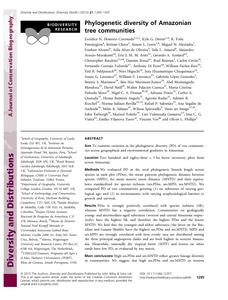Phylogenetic diversity of Amazonian tree communities
Honorio Coronado, Euridice N., Dexter, Kyle G., Pennington, Toby R., Chave, Jerome, Lewis, Simon, Alexiades, Miguel N., Alvarez, Esteban, Alvez de Oliveira, Atila, Amaral, Ieda L., Araujo-Murakami, Alejandro, Arets, Eric A., Aymard, Gerardo A., Baraloto, Christopher, Bonal, Damien, Brienen, Roel, Ceron, Carlos, Cornejo Valverde, Fernando, Di Fiore, Anthony, Farfan-Rios, William, Feldpausch, Ted R., Higuchi, Niro, Huamantupa-Chuquimaco, Isau, Laurance, Susan G., Laurance, William F., López-González, Gabriela, Marimon, Beatriz S., Marimon-Junior, Ben Hur, Monteagudo Mendoza, Abel, Neill, David, Palacios Cuenca, Walter, Penuela Mora, Maria Christina, Pitman, Nigel C.A., Prieto, Adriana, Quesada, Carlos, Ramirez Angulo, Hirma, Rudas, Agustín, Ruschell, Ademir, Salinas Revilla, Norma, Salomão, Rafael, Segalin de Andrade, Ana, Silman, Miles, Spironello, Wilson, er Steege, Hans, Terborgh, John, Toledo, Marisol, Valenzuela Gamarra, Luis, Vieria, Ima C.G., Vilanova Torres, Emilio, Vos, Vincent, and Phillips, Oliver L. (2015) Phylogenetic diversity of Amazonian tree communities. Diversity and Distributions, 21. pp. 1295-1307.
![[img]](https://researchonline.jcu.edu.au/42314/1.hassmallThumbnailVersion/Honorio%20et%20al.%202015-Amazonian%20tree%20phylodiversity.pdf)
|
PDF (Published Version)
- Published Version
Available under License Creative Commons Attribution. Download (372kB) | Preview |
Abstract
Aim: To examine variation in the phylogenetic diversity (PD) of tree communities across geographical and environmental gradients in Amazonia.
Location: Two hundred and eighty-three c. 1 ha forest inventory plots from across Amazonia.
Methods: We evaluated PD as the total phylogenetic branch length across species in each plot (PDss), the mean pairwise phylogenetic distance between species (MPD), the mean nearest taxon distance (MNTD) and their equivalents standardized for species richness (ses.PDss, ses.MPD, ses.MNTD). We compared PD of tree communities growing (1) on substrates of varying geological age; and (2) in environments with varying ecophysiological barriers to growth and survival.
Results: PDss is strongly positively correlated with species richness (SR), whereas MNTD has a negative correlation. Communities on geologically young- and intermediate-aged substrates (western and central Amazonia respectively) have the highest SR, and therefore the highest PDss and the lowest MNTD. We find that the youngest and oldest substrates (the latter on the Brazilian and Guiana Shields) have the highest ses.PDss and ses.MNTD. MPD and ses. MPD are strongly correlated with how evenly taxa are distributed among the three principal angiosperm clades and are both highest in western Amazonia. Meanwhile, seasonally dry tropical forest (SDTF) and forests on white sands have low PD, as evaluated by any metric.
Main conclusions High ses.PDss and ses.MNTD reflect greater lineage diversity in communities. We suggest that high ses.PDss and ses.MNTD in westernAmazonia results from its favourable, easy-to-colonize environment, whereas high values in the Brazilian and Guianan Shields may be due to accumulation of lineages over a longer period of time. White-sand forests and SDTF are dominated by close relatives from fewer lineages, perhaps reflecting ecophysiological barriers that are difficult to surmount evolutionarily. Because MPD and ses.MPD do not reflect lineage diversity per se, we suggest that PDss, ses.PDss and ses.MNTD may be the most useful diversity metrics for setting large-scale conservation priorities.
| Item ID: | 42314 |
|---|---|
| Item Type: | Article (Research - C1) |
| ISSN: | 1472-4642 |
| Keywords: | Amazon basin, eudicots, magnoliids, monocots, phylogenetic diversity, species richness |
| Additional Information: | © 2015 The Authors. Diversity and Distributions Published by John Wiley & Sons Ltd. This is an open access article under the terms of the Creative Commons Attribution License, which permits use, distribution and reproduction in any medium, provided the original work is properly cited. |
| Funders: | Fondo para la Innovación, Ciencia y Tecnología (FINCyT), University of Leeds, GBR, Royal Botanic Garden, Edinburgh, National Environment Research Program (NERP), Gordon and Betty Moore Foundation (GBMF), European Union Seventh Framework Programme (EU FP7), European Research Council (ERC) |
| Projects and Grants: | NERP Niche evolution of South American trees NE/I028122/1, NERP AMAZONICA NE/F005806/1, NERP TROBIT NE/D005590/1, EU FP7 283080 GEO CARBON, EU FP7 282664 AMAZALERT, ERC grant 'Tropical Forests in the Changing Earth System' |
| Date Deposited: | 02 Feb 2016 00:10 |
| FoR Codes: | 05 ENVIRONMENTAL SCIENCES > 0502 Environmental Science and Management > 050202 Conservation and Biodiversity @ 100% |
| SEO Codes: | 96 ENVIRONMENT > 9608 Flora, Fauna and Biodiversity > 960899 Flora, Fauna and Biodiversity of Environments not elsewhere classified @ 100% |
| Downloads: |
Total: 1145 Last 12 Months: 8 |
| More Statistics |




